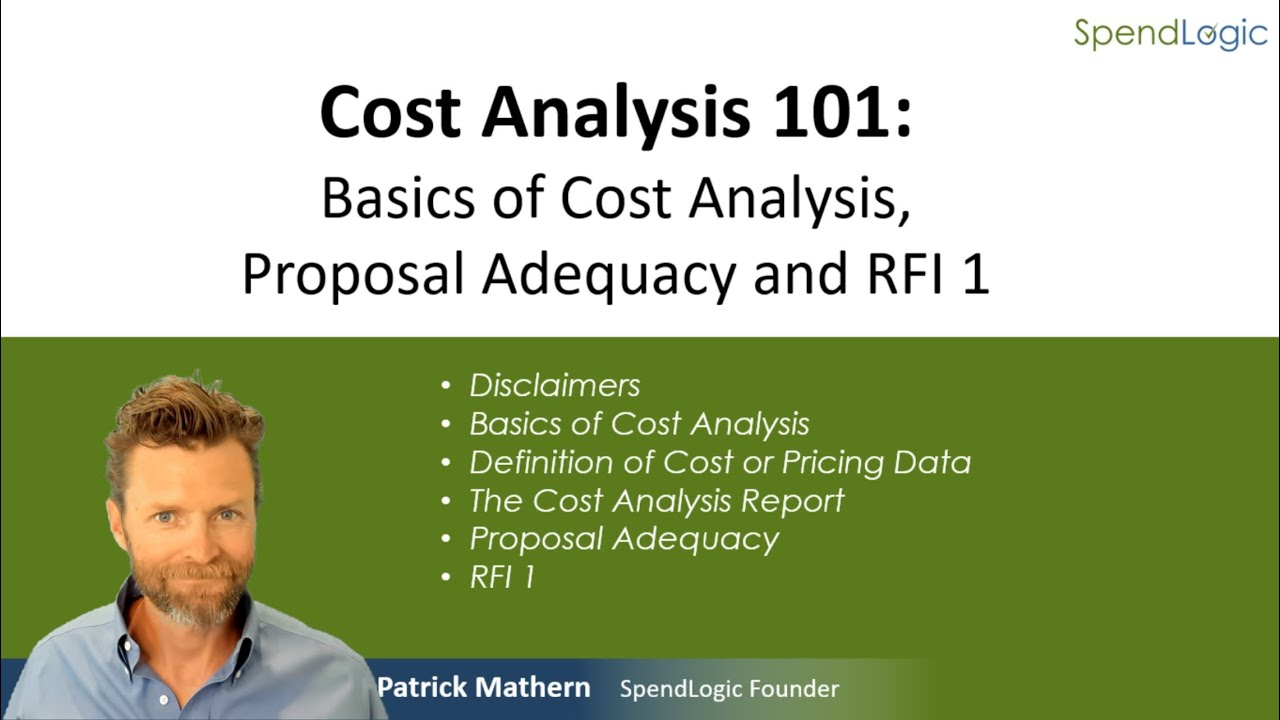Cost and Price Analysis for Government Contracts / When a Cost Analysis is Needed
If you are beginning the process of submitting bids for government contracts, it helps to know how cost and price analyses by local and federal agencies work. Being well prepared not only benefits you during the bidding and negotiation process, but it also answers questions that would otherwise surprise you during a negotiation.
The good news is government agencies follow well-defined procedures, and you can plan for them. It pays to know how it all works.
In this article, we will discuss cost and price analysis when bidding on government contracts. The two may sound the same, but knowing the difference will ensure you are prepared to win that important job.
VIDEO – WATCH NOW:
Beginner’s Guide to Cost and Price Analysis for Government Contractors and Contracting Officers
Your bid will be evaluated and approved by a government contracting officer pursuant to FAR requirements. The Federal Acquisition Regulation (FAR) 15.402 requires government contracting officers to purchase supplies and services from “responsible sources at fair and reasonable prices.” To accomplish this goal, they will conduct a price analysis or, if needed, a cost analysis. The two may sound the same, but how are they different?
What is the Difference Between a Cost Analysis and Price Analysis?
If possible, the contracting officer will use price analysis techniques that include reviewing individual unit prices and comparing your bid with other factors like the market price and historical prices, as well as follow a given series of evaluation steps. If price analysis proves insufficient for determining price reasonableness, the contracting officer may require cost analysis. Cost analysis requires a detailed review of cost or pricing data, which may include labor hours, material dollars, and direct and indirect rates. Cost analysis, under some circumstances, is required by public law for both government agencies and prime contractors. In the absence of adequate price competition, the requirement for cost analysis is important to safeguarding taxpayer funds. Without market forces, additional steps are required to determine reasonable prices for unique goods and services.
Pricing Elements of a Government Contract
To fulfill the FAR 15.402 – Pricing Policy, your pricing data submissions will need to satisfy specific documentation requirements held by the Contracting Officer or Prime Contractor. Subcontractors’ data submissions must conform to their own pricing policies and procedures. If practices to not conform to procedures, buyers will need to conduct an in-depth pricing inquiry.
To ensure you are properly prepared, it’s good to do an informal price analysis of your own and then enlist the help of a professional. At SpendLogic, we can do informal and formal analysis for you.
VIDEO – WATCH NOW:
Price Analysis for Contractors – What to Include
Realize that when the Prime Contractor or Contracting Officer receives your proposal, it will be subjected to a price analysis. Your proposal should include separate line items for each deliverable as well as any data that might support your price. This could be redacted invoices to other customers, market research of competitors’ pricing, or bottoms-up cost data. If you are seeking an exception to certification requirements, be sure to include determination documents for all commercial item acquisitions.
When Conditions Require a Cost Analysis
Unless required by law, the Prime Contractor or Contracting Officer will attempt to conduct a price analysis first. If price analysis presents an unacceptable risk, an opinion of price reasonableness cannot be made, or if required by law, your proposal will be subject to a cost analysis.
Cost analysis is a review and evaluation of separate cost elements and profit to make a determination of reasonable prices. If your pricing exceeds the FAR pricing threshold, cost data requires certification, as well as a cost analysis. Here are all elements that determine if certification is needed:
1) There is not adequate price competition
2) Pricing is not set by law or regulation
3) Your offering is not for a commercial item or service
4) No Truthful Cost or Pricing Data (TCOPD) waiver is obtained
The Cost Analysis Process
The process can be linear, or you may experience circular requirements due to revisiting the cost information you provide. It is all based on the quality of the original proposal and how well you answer the questions presented by the buyer.
The most linear of processes is as follows: An RFP is received at which point you develop and submit a proposal matching the cost analysis requirements and contract compliance requirements, among others applicable necessities (technical requirements, competition requirements, etc.) Then there will be a process of fact-finding and analysis, in which you provide the buyer with additional information he or she needs. Once those needs are fulfilled, you will enter a negotiation phase. When a final price is met, the official cost and price analysis phase is complete and a final certification is signed.
The repetitive, or circular, phases occur during the fact finding and negotiation stages. At this point, the buyer reviews the data provided with the pricing proposal and will most likely ask questions. As each round of questions are answered, the officer will create a Cost Analysis Report, which become the basis for the negotiation objectives. If new questions come up during the negotiation stage, or if questions are not answered sufficiently in fact finding, you may experience circular requirements in which you will need to answer more questions. The numbers are then re-analyzed, the Cost Analysis Report (CAR) is revised, and a new negotiation objectives may be set.
You can avoid all of this by understanding the essential elements of a cost analysis. If cost analysis affects your company infrequently, consider hiring a professional to help.
Elements of a Cost Analysis
In a cost analysis, certified cost or pricing data refers to fact-based objective data that led to your future cost projections and any representation of costs that occurred in the past. Reasonableness comes into play when subjective conclusions to objective data are required. Elements to include are:
Actual labor hours required for past deliverables
- Contractor and subcontractor costs
- Vendor proposals
- Non-reccurring costs
- Information on changes to methods and purchasing volume
- Realistic data projections
- Unit cost trends
- Make-or-buy decisions
- Estimated resources to accomplish your goal
- Management decisions that could influence costs
Price Evaluation by Agencies and Primes: Verification, Not Torture
In case you’re reading this from the perspective of the seller, this final tidbit is for you. The cost analysis process applied to government contracts aims to protect taxpayers from being over-charged. It’s important to understand that this process is designed to determine price reasonableness. It isn’t intended as an opportunity to gouge you, and when you undergo a cost analysis, you aren’t presumed to be guilty. If you approach the process with a defensive position, it will be much more difficult for you.
Contracting officers and buyers are paid to have a sharp eye and watchful for situations that could imply overcharging. They will review your previous contract prices and conduct a competition if they feel that either your costs ar out of line, or if you’re difficult to deal with in a cost analysis. Keep your pencils sharp. Your price lists and the basis of prices in your price proposals should be both fair and supported with data. This will ensure faster compliance reviews and reduce the likelihood of competition. If you are defiant, it won’t bode well for future bidding, since the buyer may see you as a potential issue.
As you gain experience in government contracting, you may find you’ll be more open to different types of contracts. For instance, fixed-price contract with economic price adjustment provides for upward and downward changes to the contract price based on certain contingencies. Would THAT be handy the next time we sudden economic downturn?
Closer Instruction on How the Process Works
Our handy Powerpoint Guide covers both cost analysis and price analysis. Keep it handy as you work through the process. And if you are looking to put your best foot forward in an upcoming factfind, reduce negotiation timelines, and improve margins, enlist an expert. SpendLogic specializes in providing subcontract cost and price analysis solutions and services to government prime contractors and subcontractors. Our experience can be your guide.






 SpendFile Documentation Folders
SpendFile Documentation Folders